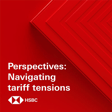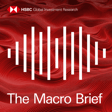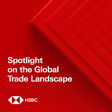Become a Creator today!Start creating today - Share your story with the world!
Start for free
00:00:00
00:00:01

The Macro Viewpoint - Tough times for UK firms, “new normal” for trade, lower for longer yields
We look at how the deteriorating economic outlook could increase the pressure on UK businesses, consider whether trade disruptions are here to stay and assess the outlook for global bond yields. Disclaimer To stay connected and to access free to view reports and videos from HSBC Global Research click here
Hosted on Acast. See acast.com/privacy for more information.
Transcript
Introduction to Global Insights
00:00:01
Speaker
Welcome to HSBC Global Viewpoint, the podcast series that brings together business leaders and industry experts to explore the latest global insights, trends and opportunities.
00:00:13
Speaker
Make sure you're subscribed to stay up to date with new episodes.
00:00:16
Speaker
Thanks for listening.
00:00:17
Speaker
And now onto today's show.
00:00:23
Speaker
You're listening to the HSBC Global Research Macro Viewpoint, our weekly review of the key reports from our economists and strategists across the globe.
00:00:34
Speaker
Hello, I'm Aline van Dyne.
00:00:37
Speaker
And I'm Piers Butler.
00:00:38
Speaker
We're back from our summer break, ready to bring you the best of our research published over the past week.
UK Economic Pressures: New Normals and Challenges
00:00:43
Speaker
Coming up today… We look at how the deteriorating economic outlook could increase the pressure on UK businesses.
00:00:51
Speaker
We consider whether ongoing disruption is now the new normal for supply chains.
00:00:57
Speaker
And we assess the outlook for global bond yields as major central banks continue to raise interest rates.
00:01:04
Speaker
This podcast was recorded on Thursday the 1st of September 2022.
00:01:07
Speaker
Our full disclosures and disclaimers can be found in the link attached to this podcast.
00:01:14
Speaker
Here in the UK, there's a lot of attention on the soaring cost of energy and the implications for households.
00:01:20
Speaker
But what about the impact on businesses?
00:01:22
Speaker
Liz Martins, senior UK economist, has been looking at why there are tough times ahead for UK PLC.
00:01:29
Speaker
Liz, welcome to the podcast.
00:01:31
Speaker
Thank you.
00:01:32
Speaker
So, Liz, just how badly are businesses being affected by this deteriorating economic backdrop?
00:01:37
Speaker
Well, I mean, clearly it depends from business to business.
00:01:40
Speaker
But what we are hearing a lot about at the moment is businesses starting to receive their energy bills for the next year.
00:01:47
Speaker
So a lot of businesses have energy costs fixed in for longer periods than households.
00:01:51
Speaker
The shock is only starting to come now.
00:01:54
Speaker
And the anecdotal evidence suggests that new bills are coming in five, six, seven times what businesses were previously paying.
00:02:01
Speaker
And for many smaller businesses in particular, that's proving a fatal blow and they're actually being forced to close down.
00:02:07
Speaker
So this is a very serious development for UK companies.
00:02:11
Speaker
And do you expect margins to be squeezed further?
00:02:14
Speaker
Yeah, I mean, UK companies are going into this with decent margins, but we do expect them to be squeezed.
00:02:21
Speaker
The pressure's already on and we expect that to continue.
00:02:23
Speaker
And we lay out four reasons for that.
00:02:25
Speaker
One is these huge energy bills that I've mentioned.
00:02:29
Speaker
Two is rising staff costs.
00:02:31
Speaker
You know, the higher inflation goes, the higher wage demands are going to be.
00:02:34
Speaker
And we're starting to see strike actions spill over into the private sector as well.
00:02:40
Speaker
The third is higher interest rates, which companies aren't in a terrible position for leverage, but a lot of the debt that they do have is on floating rates.
00:02:51
Speaker
So that pushes up on their costs.
00:02:53
Speaker
And the final one is limited pricing power in an environment where we're seeing household demand starting to fall.
00:03:02
Speaker
So if that's the case, then it's harder for them to put their own prices up to keep those margins stable.
00:03:07
Speaker
So all in all, yes, we do see
00:03:09
Speaker
further falls in margins, unfortunately.
00:03:11
Speaker
So what can companies do?
00:03:13
Speaker
And what about government support?
00:03:15
Speaker
Well, I think companies have really only two options.
00:03:17
Speaker
You put your prices up or you cut costs.
00:03:20
Speaker
Putting prices up, as I've just mentioned, looks pretty difficult in this environment, particularly because we also look in this inventory.
00:03:27
Speaker
And a lot of companies have built up inventories to quite
00:03:30
Speaker
healthy positions, which means they may actually be forced to cut costs to get rid of some of this stock into the winter.
00:03:38
Speaker
And that leaves us with job cuts, unfortunately.
00:03:40
Speaker
And although the labour market has been incredibly healthy, I guess, since the pandemic, you know, this next phase of our kind of economic journey does suggest that maybe job losses are ahead as companies cope with these higher costs.
00:03:56
Speaker
But as you said, government support is an additional factor that we need to take into consideration.
00:04:00
Speaker
And we simply don't know what support will be available.
00:04:03
Speaker
You know, we'll find out soon the UK's new prime minister looks likely to be Liz Truss.
00:04:08
Speaker
Presumably there will be something in her budget in September for companies.
00:04:13
Speaker
But she hasn't said very much about that other than the cut to national insurance contributions, which will help a bit, but not probably enough.
00:04:22
Speaker
So we'll be looking to see what additional support comes from the government.
00:04:25
Speaker
Finally, what does this tell us about the economic outlook?
Inflation and Supply Chain Dynamics
00:04:29
Speaker
Well, I think if we put together the weak pricing power, those high levels of inventories and the weak demand in the economy, it supports our view that inflation is going to come back down towards the end of next year.
00:04:43
Speaker
But then if we look at the margin compression story, I think we can see risks to that.
00:04:48
Speaker
And I mentioned two risks.
00:04:50
Speaker
One is that demand in the economy stays higher, whether through government support, whether through higher wages,
00:04:56
Speaker
And that means that inflation stays higher for longer and actually that companies are able to put more of their cost increases through and pass them on to us as consumers.
00:05:06
Speaker
But the other risk for higher inflation is on the supply side, because, of course, if you are a company that's closing down, then you are decreasing the supply of goods and services.
00:05:16
Speaker
in the economy.
00:05:16
Speaker
Or the example we give in the report is airlines.
00:05:19
Speaker
Airlines are cancelling flights in the winter to save on costs and because of staff shortages.
00:05:25
Speaker
Now, that means there are fewer places on planes flying this winter, and that may drive up the prices of those seats that are remaining.
00:05:34
Speaker
So two risks, I guess, of higher inflation.
00:05:36
Speaker
One is higher demand and one is weaker supply.
00:05:39
Speaker
Liz, thank you very much for your time.
00:05:41
Speaker
Thank you.
00:05:45
Speaker
High energy prices aren't the only issue facing corporates.
00:05:49
Speaker
Port worker strikes and even low water levels are all impacting freight movements.
00:05:54
Speaker
Shanela Rajaniagam, trade economist, has been looking at what these disruptions mean for supply chains.
00:06:02
Speaker
So, Shanela, let's start with some good news.
00:06:05
Speaker
It looks like pandemic-related supply chain strains are continuing to ease.
00:06:10
Speaker
That's right.
00:06:11
Speaker
So there are some bright spots on the horizon when it comes to trade.
00:06:14
Speaker
It does look as though some of those pandemic-related trade disruptions are starting to abate.
00:06:20
Speaker
When we look at the New York Fed's Global Supply Chain Pressures Index, for example, that actually reached an 18-month low in July.
00:06:29
Speaker
Global container spot rates are also tumbling.
00:06:32
Speaker
Rates are down nearly 50% from their pandemic peak in September 2021.
00:06:38
Speaker
Global supply delivery times across a range of sectors are also starting to ease a little bit, although they do still remain quite extended.
00:06:48
Speaker
So all up some positive signs for these pandemic-related trade disruptions.
00:06:55
Speaker
And what's been the impact of soaring energy prices?
Trade Balances and Global Impacts
00:06:59
Speaker
So when it comes to energy on the trade side, it is very clear that supplies do remain constrained.
00:07:05
Speaker
And last week, for example, capacity through the Nord Stream pipeline was actually at only at around 20% of full capacity.
00:07:14
Speaker
And then just recently, flows have actually been shut from the 31st of August for three days.
00:07:22
Speaker
So we're in this world where there's constrained supply and high energy prices as well.
00:07:28
Speaker
And this is really impacting trade balances for some economies.
00:07:32
Speaker
So, for example, the UK goods and services trade deficit actually widened to the largest on record in the second quarter this year.
00:07:40
Speaker
And similarly for Japan, its goods trade deficit hit an all time high in July.
00:07:48
Speaker
However, it is also worth mentioning that the flip side to all of this, so you do have economies like Norway and Canada who are benefiting from higher prices for their energy exports.
00:08:01
Speaker
What are the data telling us about a potential slowdown in trade?
00:08:05
Speaker
So this is something that we have been flagging for some time now, because over the past couple of years, there was this very strong pandemic induced boom for trade.
00:08:16
Speaker
And mechanically, we do expect this to start to wane as economies open up.
00:08:21
Speaker
And that is starting to play out to a certain extent now.
00:08:26
Speaker
So when we do look at some of those macro indicators like the PMIs, we do see that global new export orders, for instance, declined for the fifth consecutive month in July.
00:08:38
Speaker
And this was broad based.
00:08:39
Speaker
So you have export orders falling for the auto sector, for construction materials and even for industrial goods as well.
00:08:49
Speaker
And even when it comes to electronics, new export orders for Taiwanese electronics also declined in July.
00:08:56
Speaker
And this was really as customer inventories continued to grow.
00:09:00
Speaker
And this issue around inventories is
00:09:03
Speaker
something to flag because over the past couple of years, businesses have built up quite large stocks of inventories in some sectors.
00:09:11
Speaker
So there is a question around how they will maybe deplete these in the face of slowing consumer demand.
00:09:19
Speaker
And so overall, we do expect trade growth momentum to actually start to moderate in the coming months and quarters.
00:09:28
Speaker
So are these disruptions the new normal for trade?
00:09:32
Speaker
So I think we can say that we're not really out of the woods yet when it comes to trade disruptions.
00:09:39
Speaker
So yes, as we mentioned, there are some signs that these pandemic related disruptions are starting to ease.
00:09:46
Speaker
But it's very clear that businesses are now grappling with a host of new trade challenges.
00:09:51
Speaker
So you have
00:09:52
Speaker
high inflation, you have port worker strikes, low water levels in some German rivers, and of course, ongoing geopolitical issues as well.
00:10:02
Speaker
So it is a very uncertain landscape for exporters and importers.
00:10:07
Speaker
So I think, you know, to answer the question, I think we can say that ongoing disruption certainly seems like the new normal, at least for now.
00:10:15
Speaker
Shanela, thanks very much.
00:10:17
Speaker
Thanks for having me.
00:10:22
Speaker
Before we move on, we'd like to invite you to HSBC's Global Emerging Markets Forum, which will take place online from the 13th to the 30th of September.
00:10:31
Speaker
Over three weeks, policymakers, thought leaders, corporates and our team of experts here in global research will be sharing their views on the outlook for emerging markets.
00:10:41
Speaker
If you're interested in attending, please contact your local HSBC representative for more details.
Bond Yields and Economic Narratives
00:10:49
Speaker
Our fixed income team have long held the view that bond yields will be lower for longer.
00:10:54
Speaker
Stephen Major, Global Head of Fixed Income Research, has revisited the topic and explains why he thinks it is as relevant as ever.
00:11:02
Speaker
He spoke to Graham McKay in Hong Kong earlier.
00:11:04
Speaker
So, Steve, the message from Jackson Hole has been pretty clear.
00:11:07
Speaker
Interest rates are going to stay elevated, at least until inflation starts to come down.
00:11:12
Speaker
What's your initial response to that?
00:11:14
Speaker
Obviously, it's a challenge to the lower for longer thesis.
00:11:17
Speaker
That's fair enough.
00:11:18
Speaker
And actually, Jackson Hole was a motivation for going for this paper.
00:11:26
Speaker
And I guess the other motivation was we were due to check in on the theme.
00:11:32
Speaker
But I look at Jackson Hole slightly differently.
00:11:36
Speaker
The narrative, without doubt, has been higher for longer.
00:11:40
Speaker
And central banks have been quite concerted and coordinated in getting that message across.
00:11:44
Speaker
But looking into the transcripts and the discussions and the panels, there's a much deeper discussion going on, which I think is consistent with lower for longer rates.
00:11:56
Speaker
Can you elaborate on that?
00:11:58
Speaker
Well, yeah.
00:11:59
Speaker
So whilst it's true that the market implies rates being 3% or high threes for the policy rate and above three for the 10-year right now, whilst that is what you can see,
00:12:15
Speaker
the key variable for valuing a 10-year bond is where policy rates will be five years hence.
00:12:23
Speaker
So look, imagine if the average yield for a bond was 3% for the next five years and then 1% for the following five years.
00:12:33
Speaker
The average of those two is 2, 2.0.
00:12:38
Speaker
That's why when bond yields are above three, they're implying that not only are rates going up, they're going to stay up for a very long time.
00:12:47
Speaker
So my thinking is the higher they go near term, the increase in the probability needs to be considered and where they go in the longer term.
00:12:57
Speaker
The determinants of what drives the longer run policy rate are the ones that matter and they don't change overnight.
00:13:06
Speaker
Remind us what the key pillars of Lower for Longer are.
00:13:09
Speaker
Well, it starts with debt, then aging populations, inequality, the central bank QE becoming QT, and then the connections between markets and how money flows from one place to another to get more yield.
00:13:27
Speaker
They are connected.
00:13:28
Speaker
So think about aging populations and high debt, like in Japan.
00:13:34
Speaker
And think about how wealth inequality interacts with savings and debt.
00:13:41
Speaker
It's the poorer cohorts who don't have the savings but do have the debt.
00:13:46
Speaker
So when rates go up, there's a disproportionate impact.
00:13:50
Speaker
I think this is all being underestimated.
00:13:52
Speaker
So these rate hikes are going to really pack some punch.
00:13:58
Speaker
Right.
00:13:58
Speaker
And what are the key areas of pushback against your view?
00:14:02
Speaker
Yeah, they come thick and fast.
00:14:04
Speaker
So there's a general view out there that higher for longer means the opposite of lower for longer.
00:14:11
Speaker
Well, it's true.
00:14:12
Speaker
Rates are going to, perhaps, if the Fed is right, they're going to stay high for the next year or so.
00:14:19
Speaker
The Fed is often wrong, by the way.
00:14:21
Speaker
But if we just take a base case that they do what they say they're going to do, and
00:14:26
Speaker
But that isn't itself a proper pushback because we're talking about the rates five years from now.
00:14:33
Speaker
The big pushback that I think starts to be difficult to argue against is reverse globalization, the way supply chains are being reimagined, tariffs and that kind of thing.
00:14:46
Speaker
The labour market's a big pushback in that labour starts to take a bigger share of profits.
00:14:53
Speaker
I look into those two and I think, well, we don't really know on the first one, because to me there's a sort of multimodal trade reconfiguration going on such that you have a big free trade zone that we know about here in Asia.
00:15:08
Speaker
And there's a big one in the EU and the Americas.
00:15:12
Speaker
And do you know, for example, that Mexico is offering a cheaper unit labour cost than China at the moment from a US perspective?
00:15:18
Speaker
So there's a few things to consider.
00:15:20
Speaker
On labour and unit labour costs on labour in general, I think most ordinary people will feel quite poor at the moment.
00:15:27
Speaker
Even if their wages have gone up, they haven't kept pace with inflation.
00:15:32
Speaker
So I push back on the pushback, if you know what I mean.
00:15:34
Speaker
Thank you very much, Steve.
00:15:36
Speaker
Thank you, Graham.
00:15:39
Speaker
So that's it for today.
00:15:41
Speaker
Thank you to our guests Liz Martins, Shanela Rajanagam and Stephen Major.
00:15:45
Speaker
From all of us here, thanks for listening.
00:15:47
Speaker
We'll be back again next week.
00:16:08
Speaker
Thank you for joining us at HSBC Global Viewpoint.
00:16:12
Speaker
We hope you enjoyed the discussion.
00:16:14
Speaker
Make sure you're subscribed to stay up to date with new episodes.
















